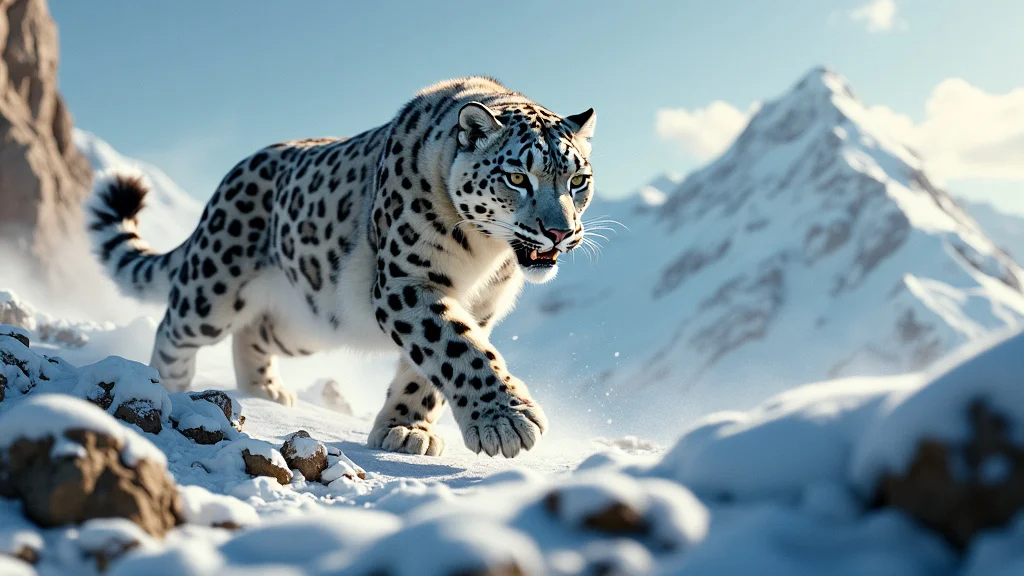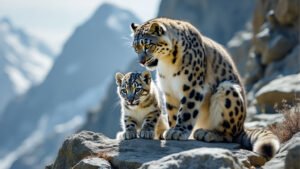Introduction
Snow leopards, known for their elusive nature and ability to thrive in some of the world’s most rugged terrains, face numerous challenges that affect their lifespan in the wild
This article explores the typical lifespan of snow leopards in their natural habitat, examining how environmental factors, human activities, and conservation efforts impact their longevity
We will also compare the lifespan of wild snow leopards with those in captivity and delve into the key threats and conservation strategies aimed at ensuring the survival of these majestic creatures
Average Lifespan of Snow Leopards in the Wild
Snow leopards, scientifically known as Panthera uncia, are remarkable big cats adapted to survive in some of the most inhospitable environments on Earth. These solitary predators are native to the mountainous regions of Central and South Asia, where they navigate rugged terrain and endure extreme weather conditions
Understanding their average lifespan in the wild provides insights into their resilience and the challenges they face daily. This section will explore the typical age range of snow leopards in the wild, regional variations in their lifespan, and the impact of environmental stressors on their overall longevity
Typical Age Range Observed in Studies
In the wild, snow leopards have an average lifespan of about 10 to 12 years, although some individuals may live up to 15 years. This lifespan is relatively short compared to other big cats, such as lions or tigers, which can live longer in more hospitable environments
The shorter lifespan of snow leopards in the wild is largely due to the harsh conditions they endure, including extreme cold, scarcity of prey, and the rugged terrain they inhabit
Research conducted in the Himalayas and the Altai Mountains has shown that snow leopards typically reach maturity at around 2 to 4 years of age
Once they reach adulthood, their survival depends on their ability to hunt and avoid dangers such as avalanches, falls, or conflicts with other predators. Female snow leopards, in particular, face additional challenges as they raise cubs in these difficult conditions, which can also impact their longevity
Regional Variations in Lifespan
The lifespan of snow leopards can vary depending on the region they inhabit. In areas where prey is more abundant, such as certain parts of the Himalayas, snow leopards may live slightly longer due to better access to food and less competition with other predators
In contrast, populations in more remote and harsher regions, like the high-altitude ranges of Mongolia, may have shorter lifespans due to the increased difficulty of finding prey and the more severe environmental conditions
Additionally, snow leopards in regions with significant human encroachment face greater risks that can shorten their lifespan
These risks include poaching, retaliation killings by herders, and habitat loss due to mining or infrastructure development. These human-induced threats often lead to a decrease in the overall lifespan of snow leopards in affected areas
Impact of Environmental Stressors on Longevity
Environmental stressors play a crucial role in determining the lifespan of snow leopards in the wild. The cold, arid climates of their mountainous habitats require significant energy expenditure to maintain body heat and search for prey
During the harsh winter months, when prey is scarce and the weather is severe, snow leopards can lose substantial amounts of weight, making them more vulnerable to disease and reducing their overall lifespan
Moreover, the solitary nature of snow leopards means that each individual must establish and defend a large territory to ensure access to sufficient food resources. This constant need for territorial defense can lead to fatal encounters with other snow leopards or injuries that reduce their lifespan
Environmental changes, such as decreasing snow cover due to climate change, further exacerbate these challenges by altering the availability of prey and suitable habitats
Threats to Snow Leopards’ Lifespan
Snow leopards face numerous threats in the wild, many of which directly impact their lifespan. These threats range from natural predators and harsh environmental conditions to human activities that encroach on their habitats
Understanding these dangers is crucial for conservation efforts aimed at protecting snow leopards and ensuring their survival in the wild. In this section, we will explore the natural threats snow leopards encounter, the impact of human activities on their lifespan, and the growing threat of climate change to their survival
Natural Predators and Mortality Rates
While snow leopards are apex predators within their ecosystems, they are not immune to threats from other animals and natural dangers
In the wild, adult snow leopards have few natural predators; however, cubs are more vulnerable to attacks from larger carnivores such as wolves and bears, which share the same mountainous habitats
Mortality rates among snow leopard cubs are relatively high, with estimates suggesting that as many as 50% of cubs may not survive their first year of life due to predation or the harsh environmental conditions they face
Another significant natural threat to snow leopards is injury from falls or accidents in their rugged habitats. The steep and rocky terrain that snow leopards navigate daily poses risks, particularly when they are hunting or fleeing from danger
Injuries sustained from falls can be fatal or severely hinder a snow leopard’s ability to hunt, leading to starvation or vulnerability to other threats
Human Impact on Snow Leopards’ Survival
Human activities represent one of the most significant threats to the lifespan of snow leopards in the wild
Poaching remains a critical issue, driven by demand for snow leopard fur and bones in illegal wildlife trade. Despite international protections, poachers continue to target snow leopards, significantly reducing their populations and shortening their lifespans
Another major threat comes from conflicts with local herders. As human populations expand into snow leopard habitats, encounters between snow leopards and livestock become more common
When snow leopards prey on livestock, they are often killed in retaliation by herders, either through direct hunting or poisoning. This conflict has led to the death of numerous snow leopards, particularly in regions where alternative prey is scarce, and livestock represents an easier target for these big cats
Habitat loss due to human activities such as mining, infrastructure development, and agricultural expansion also contributes to the decreasing lifespan of snow leopards. As their natural habitats shrink, snow leopards are forced into smaller, fragmented areas where they face increased competition for food and resources, leading to higher mortality rates
Climate Change and Habitat Degradation
Climate change poses an emerging threat to the lifespan of snow leopards by altering the very ecosystems they depend on for survival. As temperatures rise, the snow-covered areas that snow leopards call home are gradually shrinking. This loss of habitat not only reduces the available space for snow leopards to live and hunt but also affects the populations of prey species that snow leopards rely on for food.
One of the critical impacts of climate change on snow leopards is the upward shift of their prey species to higher altitudes in search of cooler climates. This shift forces snow leopards to adapt to new, often more challenging environments, where food may be even scarcer
Additionally, changes in snow and ice cover can make hunting more difficult, as snow leopards rely on camouflage to stalk their prey
Moreover, the changing climate can exacerbate existing threats, such as increasing the frequency and severity of extreme weather events. Harsh winters with deep snow or prolonged cold spells can lead to starvation, particularly for younger or weaker snow leopards
Conversely, warmer temperatures can disrupt the delicate balance of the ecosystems snow leopards inhabit, leading to unpredictable changes that can further threaten their survival
Conservation Efforts and Lifespan Improvement
Conservation efforts aimed at protecting snow leopards have become increasingly vital as the threats to their survival continue to grow. These initiatives not only focus on preserving the species but also on improving the lifespan of snow leopards in the wild by mitigating the dangers they face
This section will examine the role of protected areas and reserves, the effectiveness of anti-poaching initiatives, and the importance of community engagement in conservation efforts, all of which contribute to enhancing the longevity of snow leopards in their natural habitat
Role of Protected Areas and Reserves
Protected areas and reserves play a critical role in safeguarding snow leopards and ensuring they have safe environments where they can thrive
These designated regions, often located in remote and rugged landscapes, provide snow leopards with a sanctuary from many of the threats they face outside these boundaries, such as poaching and human encroachment
One of the most significant examples of this is the creation of transboundary protected areas, which span multiple countries and allow snow leopards to move freely across borders in search of prey and suitable habitats. The Altai-Sayan region, which covers parts of Russia, Mongolia, Kazakhstan, and China, is one such area where international cooperation has led to the establishment of extensive protected zones
These efforts have been shown to contribute to the stabilization of snow leopard populations in these areas and, by extension, to their increased lifespan
In addition to protecting the land, these reserves also focus on maintaining the prey populations that snow leopards rely on. By ensuring a stable food source, these protected areas help reduce the risks associated with starvation, one of the leading causes of mortality in snow leopards
This stability is crucial for allowing snow leopards to live longer, healthier lives in the wild
Anti-Poaching Initiatives and Their Effectiveness
Anti-poaching initiatives are another cornerstone of conservation efforts aimed at improving the lifespan of snow leopards. Given that poaching is one of the most direct and immediate threats to snow leopards, these initiatives are crucial for reducing mortality rates among these big cats
Organizations like the Snow Leopard Trust and the Global Snow Leopard & Ecosystem Protection Program (GSLEP) have implemented a range of strategies to combat poaching
These include increasing patrols in known poaching hotspots, employing local community members as wildlife rangers, and using technology such as camera traps and satellite collars to monitor snow leopard populations and detect illegal activities
The effectiveness of these initiatives is evident in areas where poaching incidents have significantly decreased. For example, in Mongolia’s Tost Tosonbumba Nature Reserve, a combination of increased patrolling and community engagement has led to a noticeable decline in poaching activities, contributing to a more stable and potentially longer-lived snow leopard population
Such successes highlight the importance of continued investment in anti-poaching efforts as a means of improving the overall lifespan of snow leopards in the wild
Community Engagement in Conservation
Community engagement is a vital component of conservation efforts aimed at protecting snow leopards and improving their lifespan
In many of the regions where snow leopards are found, local communities share the landscape with these predators and often bear the brunt of human-wildlife conflict. By involving these communities in conservation, efforts can be made to reduce conflicts and foster a sense of stewardship over the local wildlife
Programs that involve local communities in conservation efforts include compensation schemes for livestock losses due to snow leopards, which help to reduce retaliatory killings. Additionally, initiatives that promote alternative livelihoods, such as eco-tourism or sustainable herding practices, provide economic incentives for locals to protect rather than harm snow leopards
These programs not only help to decrease direct threats to snow leopards but also contribute to creating an environment where these animals can live longer, safer lives
Education and awareness campaigns are also critical. By educating communities about the ecological importance of snow leopards and the long-term benefits of conservation, these programs can shift perceptions and reduce negative interactions
In areas where such community engagement efforts have been successful, there has been a marked decrease in human-related snow leopard deaths, leading to an increase in their potential lifespan
Conclusion
The lifespan of snow leopards in the wild is influenced by a complex interplay of natural and human-induced factors. On average, snow leopards live between 10 to 12 years in the wild, though this can vary based on regional conditions and environmental stressors
Natural threats such as predation, injury, and the harsh mountainous environments play significant roles in determining their longevity. However, human activities, including poaching, habitat loss, and climate change, present even more substantial challenges, often shortening their lifespan further
Efforts to improve the lifespan of snow leopards are ongoing and multifaceted. Conservation strategies such as the establishment of protected areas, anti-poaching initiatives, and community engagement have shown promise in mitigating these threats. These efforts not only help to stabilize snow leopard populations but also create conditions where these big cats can live longer, healthier lives
Continued focus on these strategies is essential for ensuring the survival of snow leopards in the wild and maintaining the ecological balance of their mountainous habitats. Through sustained and cooperative conservation actions, we can hope to see these elusive predators thrive for many years to come













